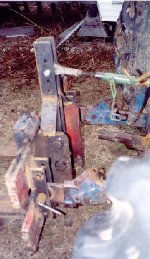B7510
Bronze Member
I just started into the realm of "make it yourself" and ran into a problem. I had a couple of 3-point impements that I wanted to build. I wanted to know how the dimensions between the 3-point connection pins on an implement affected the way the implement tilts when lowered and lifted.
I knew that I wanted my carry-all to stay at about the same angle when it was lifted. I also knew that I wanted my rock carrier to tilt back. The idea of having to get off the tractor and adjust the top link as I lifted the 1,000# rock didn't seem like the way to go.
I looked around and couldn't find anything that would give me any direction, and I kept getting diffeerent answers when I asked different folks. Well, I finally decided that when all else fails, you just have to set down for a while and figure it out.
It took me quite a while. I had to reach back 30 years and dust off my high school geometry a bit. But I think I finally got it.
Attached it a spread sheet file. It allows you to put in the basic dimensions for your tractor, lift range for your lower links, and a couple of dimensions for the implement. It then calculates how the angle of attack for the implement changes as the lower links are raised. I even got it to give you a little cartoon of the results.
You will need Microsoft Excel to run this. If you have another spread sheet let me know and I will see if I can do a "Save As" to get it into a workable format.
I knew that I wanted my carry-all to stay at about the same angle when it was lifted. I also knew that I wanted my rock carrier to tilt back. The idea of having to get off the tractor and adjust the top link as I lifted the 1,000# rock didn't seem like the way to go.
I looked around and couldn't find anything that would give me any direction, and I kept getting diffeerent answers when I asked different folks. Well, I finally decided that when all else fails, you just have to set down for a while and figure it out.
It took me quite a while. I had to reach back 30 years and dust off my high school geometry a bit. But I think I finally got it.
Attached it a spread sheet file. It allows you to put in the basic dimensions for your tractor, lift range for your lower links, and a couple of dimensions for the implement. It then calculates how the angle of attack for the implement changes as the lower links are raised. I even got it to give you a little cartoon of the results.
You will need Microsoft Excel to run this. If you have another spread sheet let me know and I will see if I can do a "Save As" to get it into a workable format.
